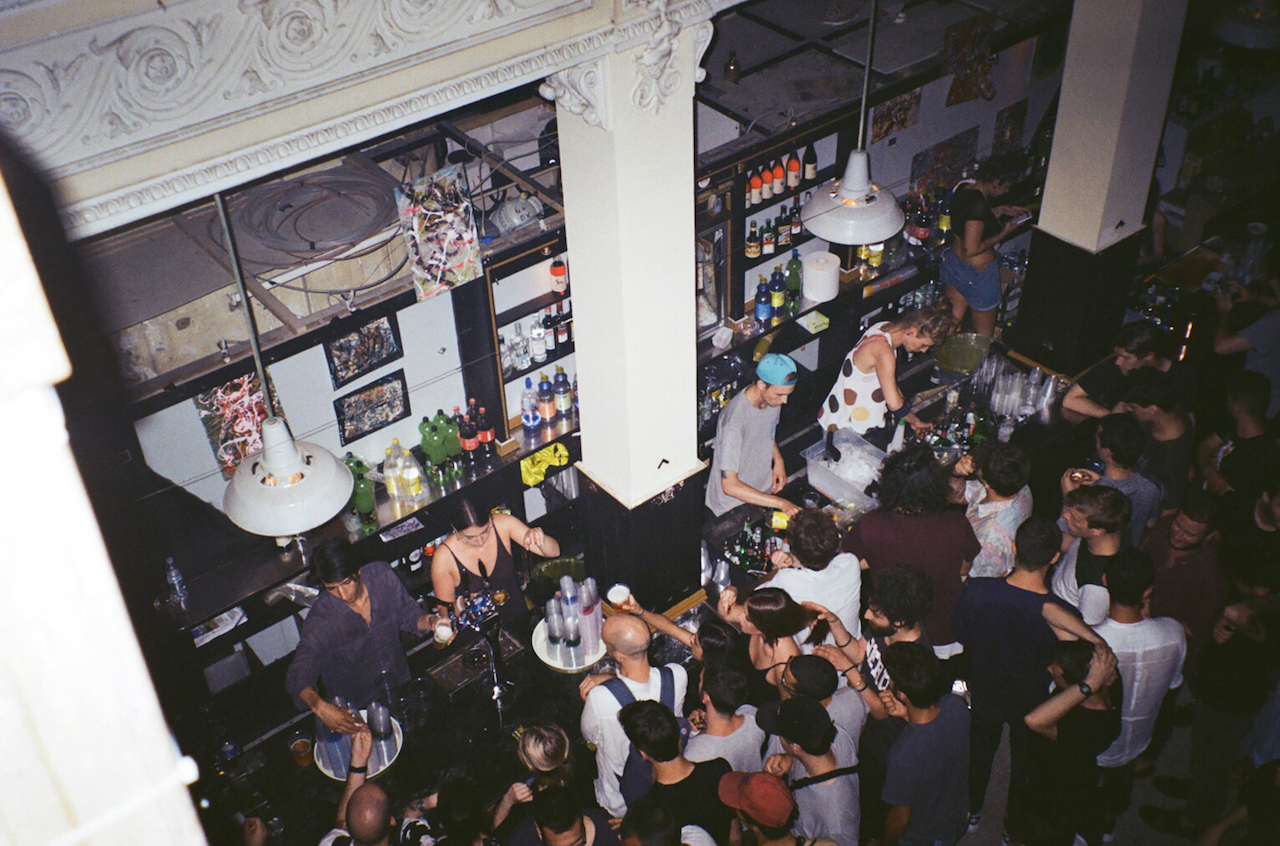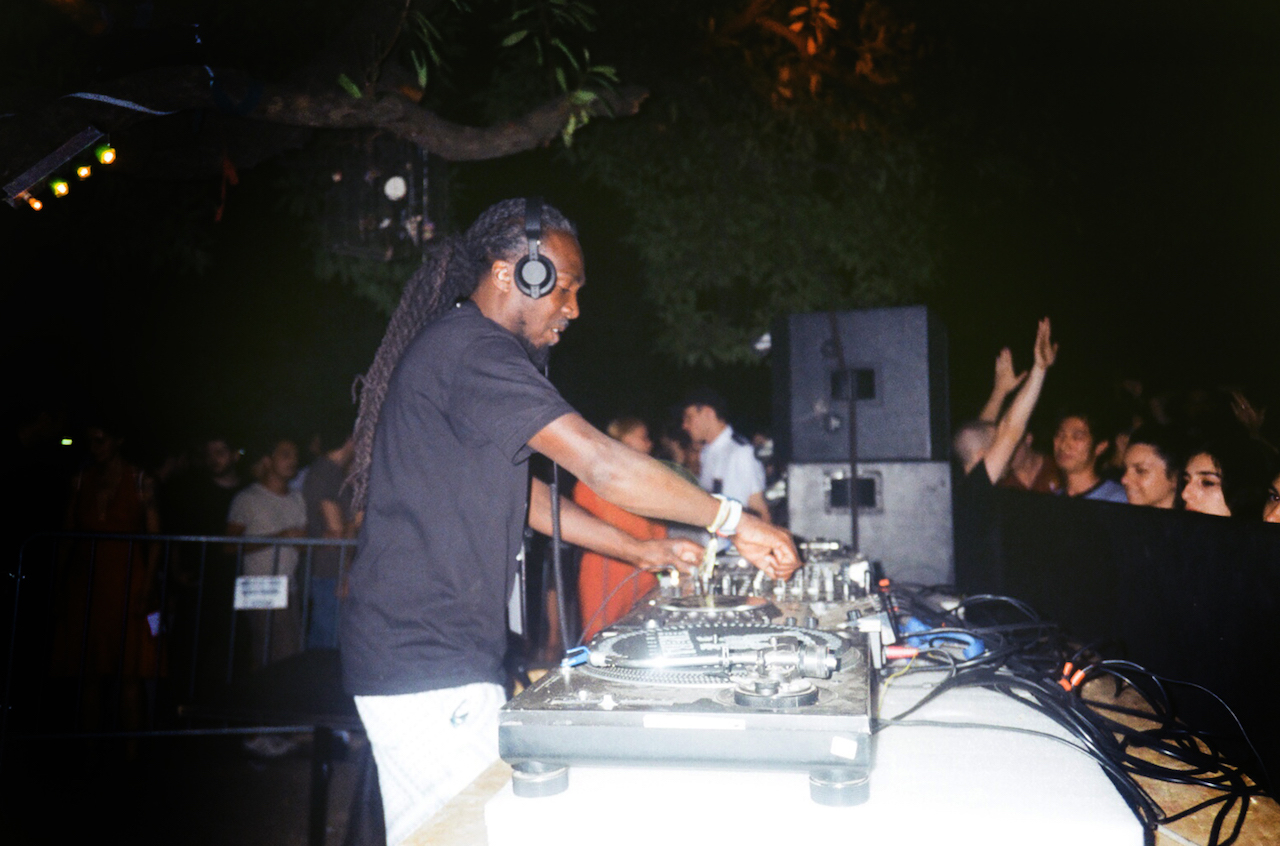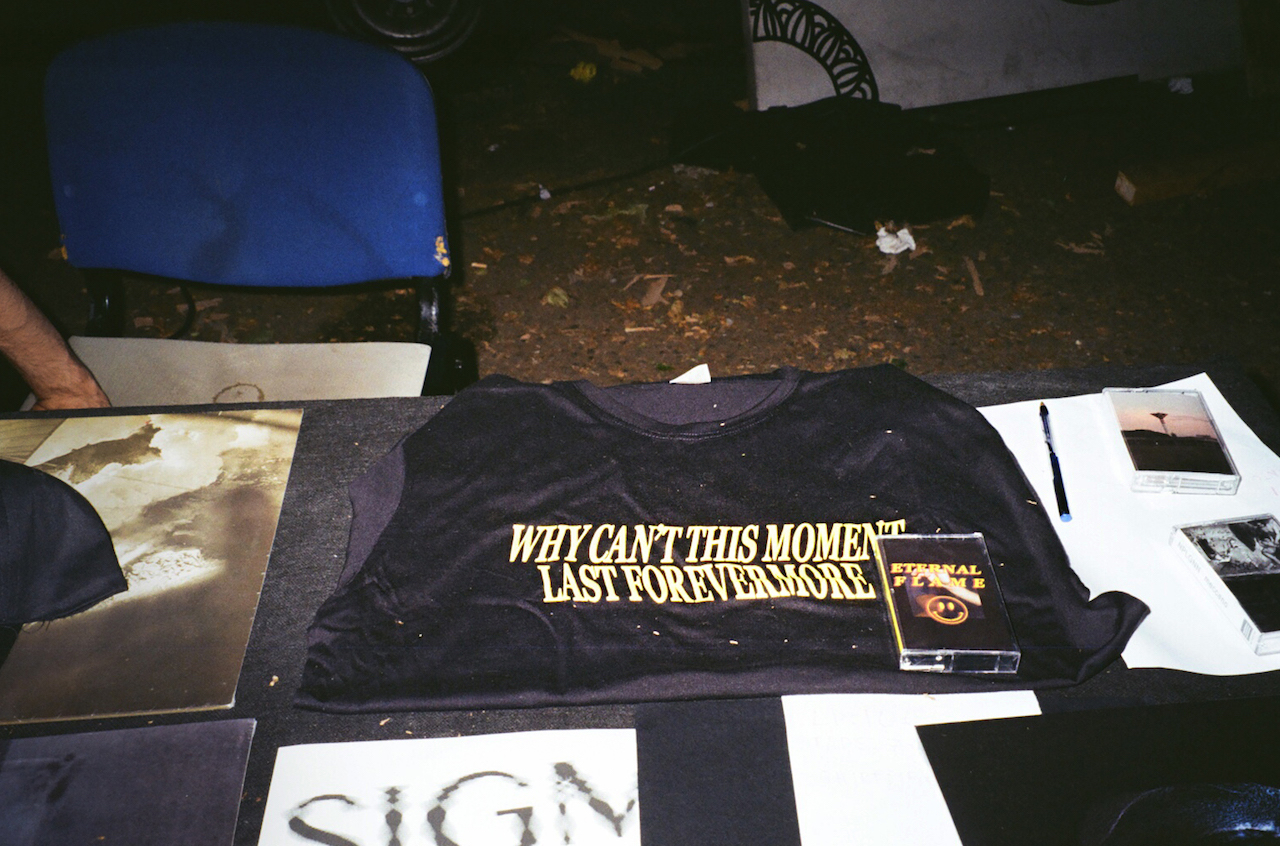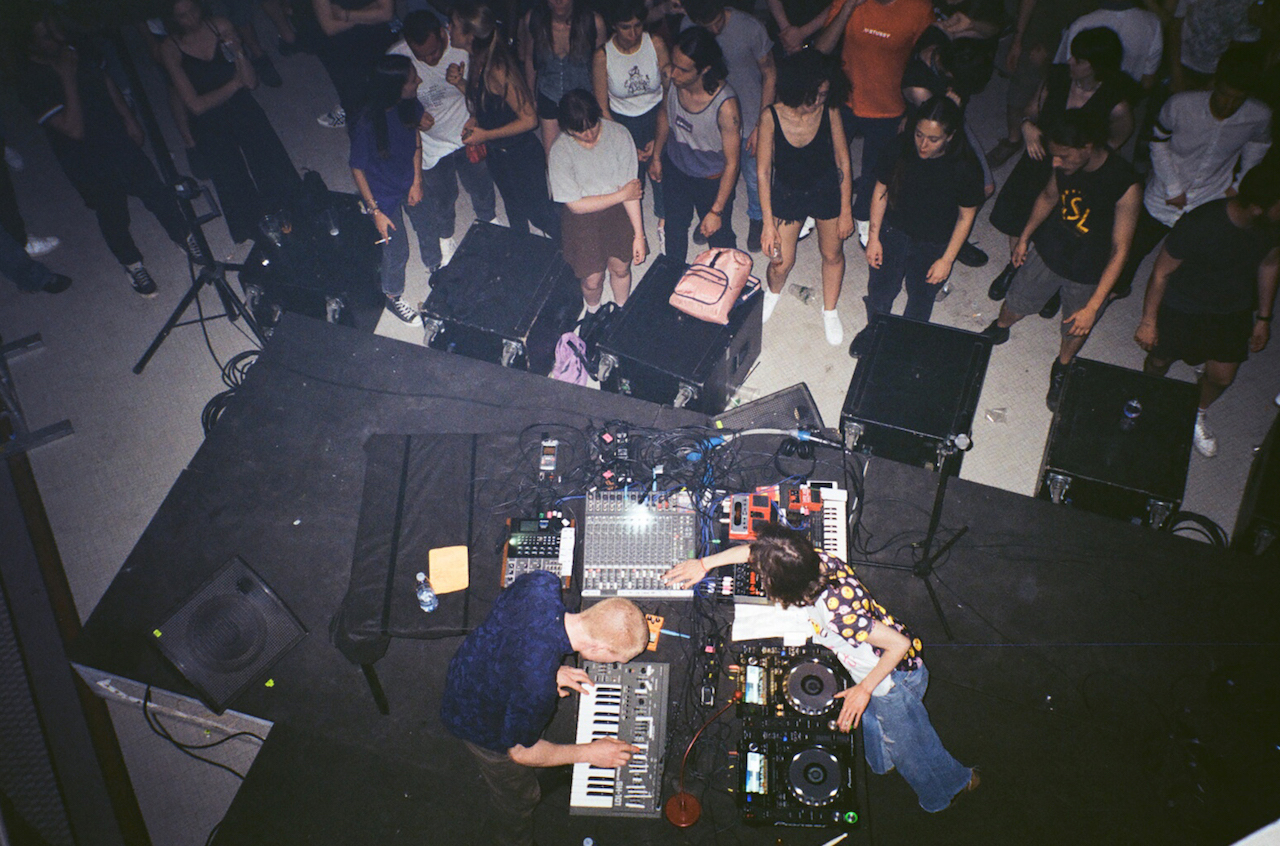- Macao, one of Milan's most intriguing locations for art and culture, stands just outside of the city center in a shabby yet imposing art nouveau building. It's a quasi-squat—a few people live there—though its existence and activities are known and tolerated by the city, even as its future lies in question. The space hosts a variety of cultural offerings, with the music program mostly organized by Tavolo Suono, a 15-strong collective who are responsible, among other things, for the annual Saturnalia Festival.
Run almost entirely by volunteers, Saturnalia kept things simple with two consecutive nighttime events, which fell across two blazing hot days last weekend. The heat meant finding a breeze in the outdoor Garden stage was regularly necessary, while Walter Prati's electronic manipulations of Evan Parker's rippling soprano saxophone improvisations had a similarly cooling effect on the brain. The performance, held on a stage under the outstretched branches of a large tree lined with lights, made for a gentle and pleasant introduction.
The Garden was also a popular hangout spot, lined around the edges with a few food and drink stalls. One stand offered peach tarts filled with fruit from the vendor's own garden. Though there was always a cluster of people at the stage, at peak capacity the crowd was thick through most of the area. Entrance was a mere €5 per day. The only downside to such a democratic ticket price was the crowd seemed more curious than completely immersed in RP Boo's reliably great footwork set. As a result, it didn't get the manic reaction it deserved. But as the night neared dawn, the crowd loosened up, flailing their limbs to Madam X's bouncy mix of dubstep, electro and UK hybrids.
With only two stages open on Friday, Syrian dabke keyboardist Rizan Said—who's best known for his longtime collaboration with Omar Souleyman—ruled the Garden space. Providing the first all-out dance set of the festival, with a specific yet accessible sound, his Arabesque modal improvisations raced at around 135 BPM and got slower and more soulful. He used his keyboard racks like a one-man band, programming drums and MIDI strings or flute sounds. Compared to the energy brought by Said, Lutto Lento's DJ set of breakbeats, hip-house, garage and dancehall sounded almost too relaxed. Friday night was scheduled to close at 3:30 AM, but by the time the final artist, Jack Roland, hit the Garden with a mix of driving techno and electro, the stage was running late, and there were far too many people there to shut it down.
The Temple, a small room for a couple of hundred people, was the other stage open on both nights. It featured a challenging soundsystem that most of the time suffered from excessive distortion, which was the case during Croatian Amor's arrangements of drone waves, slow beats and noise. There's a non-sequitur freeness to his live set, as well as an element of mournful mystery. The performance was given a surprising amount of context by the accompanying video montage of anime, Chatroulette, protest footage and a first-person shooter video game.
Perhaps due to the room, SKY H1 sounded heavier and more disjointed than usual, although the entrancing dreaminess came through later in her set. Other Temple highlights included a rare Scratcha DVA live set as DVA [HI:EMOTIONS], Age Coin's bassy rollers and sparse breakdowns and, arguably the biggest surprise of the weekend, Bernardino Femminielli, whose karaoke-style crooning was gloriously camp. A silly video ran alongside Femminielli's performance, captioned Snapchat-style with the slogans: "gloryhole" and "no gag reflex." It was both a palette cleanser and hilariously fun.
The third stage was a large indoor room called Hall, which was three to four times the size of Temple. It was only open on Saturday, though it hosted some of the weekend's most intriguing new music. Typhonian Highlife, the new project from The Skaters' Spencer Clark, was full of synthetic textures, burbling synths and new age drones. The mood veered between wild and serene. Donato Epiro's electronic sculptural noise featured rhythmic bluster worthy of Einstürzende Neubauten that melted into the delicacy of a snare. HHY & The Macumbas' drum-heavy percussion and monotone synth repetition was simple but effective freak-out music. Inga Copeland & John T. Gast's collaboration offered an unexpected version of noisy techno and grind, while Beneath's techno and bass music and Kilbourne's hardstyle and gabber were the most classic club sounds heard all night.
Saturnalia worked for two reasons: inspired programming and Macao's unique space and team of promoters, who helped create an exciting atmosphere. There were several hours, especially on Saturday night, when you could wander between the three stages and hear something interesting, joyful and adventurous every time, often from an artist you'd never heard of before. Even the biggest and best festivals have a hard time pulling that off, let alone a completely DIY operation like this one. For the audience, there is little that established events offer that Saturnalia does not, all at a fraction of the price. Spending time in such an environment—utopian, political, friendly, hedonistic yet responsible—has a noticeable affect on your psyche. History tells us that Macao probably won't last, but access to such a space is an experience that will stay with you.
Photo credit /
Redie Braun
 The Garden was also a popular hangout spot, lined around the edges with a few food and drink stalls. One stand offered peach tarts filled with fruit from the vendor's own garden. Though there was always a cluster of people at the stage, at peak capacity the crowd was thick through most of the area. Entrance was a mere €5 per day. The only downside to such a democratic ticket price was the crowd seemed more curious than completely immersed in RP Boo's reliably great footwork set. As a result, it didn't get the manic reaction it deserved. But as the night neared dawn, the crowd loosened up, flailing their limbs to Madam X's bouncy mix of dubstep, electro and UK hybrids. With only two stages open on Friday, Syrian dabke keyboardist Rizan Said—who's best known for his longtime collaboration with Omar Souleyman—ruled the Garden space. Providing the first all-out dance set of the festival, with a specific yet accessible sound, his Arabesque modal improvisations raced at around 135 BPM and got slower and more soulful. He used his keyboard racks like a one-man band, programming drums and MIDI strings or flute sounds. Compared to the energy brought by Said, Lutto Lento's DJ set of breakbeats, hip-house, garage and dancehall sounded almost too relaxed. Friday night was scheduled to close at 3:30 AM, but by the time the final artist, Jack Roland, hit the Garden with a mix of driving techno and electro, the stage was running late, and there were far too many people there to shut it down. The Temple, a small room for a couple of hundred people, was the other stage open on both nights. It featured a challenging soundsystem that most of the time suffered from excessive distortion, which was the case during Croatian Amor's arrangements of drone waves, slow beats and noise. There's a non-sequitur freeness to his live set, as well as an element of mournful mystery. The performance was given a surprising amount of context by the accompanying video montage of anime, Chatroulette, protest footage and a first-person shooter video game. Perhaps due to the room, SKY H1 sounded heavier and more disjointed than usual, although the entrancing dreaminess came through later in her set. Other Temple highlights included a rare Scratcha DVA live set as DVA [HI:EMOTIONS], Age Coin's bassy rollers and sparse breakdowns and, arguably the biggest surprise of the weekend, Bernardino Femminielli, whose karaoke-style crooning was gloriously camp. A silly video ran alongside Femminielli's performance, captioned Snapchat-style with the slogans: "gloryhole" and "no gag reflex." It was both a palette cleanser and hilariously fun.
The Garden was also a popular hangout spot, lined around the edges with a few food and drink stalls. One stand offered peach tarts filled with fruit from the vendor's own garden. Though there was always a cluster of people at the stage, at peak capacity the crowd was thick through most of the area. Entrance was a mere €5 per day. The only downside to such a democratic ticket price was the crowd seemed more curious than completely immersed in RP Boo's reliably great footwork set. As a result, it didn't get the manic reaction it deserved. But as the night neared dawn, the crowd loosened up, flailing their limbs to Madam X's bouncy mix of dubstep, electro and UK hybrids. With only two stages open on Friday, Syrian dabke keyboardist Rizan Said—who's best known for his longtime collaboration with Omar Souleyman—ruled the Garden space. Providing the first all-out dance set of the festival, with a specific yet accessible sound, his Arabesque modal improvisations raced at around 135 BPM and got slower and more soulful. He used his keyboard racks like a one-man band, programming drums and MIDI strings or flute sounds. Compared to the energy brought by Said, Lutto Lento's DJ set of breakbeats, hip-house, garage and dancehall sounded almost too relaxed. Friday night was scheduled to close at 3:30 AM, but by the time the final artist, Jack Roland, hit the Garden with a mix of driving techno and electro, the stage was running late, and there were far too many people there to shut it down. The Temple, a small room for a couple of hundred people, was the other stage open on both nights. It featured a challenging soundsystem that most of the time suffered from excessive distortion, which was the case during Croatian Amor's arrangements of drone waves, slow beats and noise. There's a non-sequitur freeness to his live set, as well as an element of mournful mystery. The performance was given a surprising amount of context by the accompanying video montage of anime, Chatroulette, protest footage and a first-person shooter video game. Perhaps due to the room, SKY H1 sounded heavier and more disjointed than usual, although the entrancing dreaminess came through later in her set. Other Temple highlights included a rare Scratcha DVA live set as DVA [HI:EMOTIONS], Age Coin's bassy rollers and sparse breakdowns and, arguably the biggest surprise of the weekend, Bernardino Femminielli, whose karaoke-style crooning was gloriously camp. A silly video ran alongside Femminielli's performance, captioned Snapchat-style with the slogans: "gloryhole" and "no gag reflex." It was both a palette cleanser and hilariously fun.
 The third stage was a large indoor room called Hall, which was three to four times the size of Temple. It was only open on Saturday, though it hosted some of the weekend's most intriguing new music. Typhonian Highlife, the new project from The Skaters' Spencer Clark, was full of synthetic textures, burbling synths and new age drones. The mood veered between wild and serene. Donato Epiro's electronic sculptural noise featured rhythmic bluster worthy of Einstürzende Neubauten that melted into the delicacy of a snare. HHY & The Macumbas' drum-heavy percussion and monotone synth repetition was simple but effective freak-out music. Inga Copeland & John T. Gast's collaboration offered an unexpected version of noisy techno and grind, while Beneath's techno and bass music and Kilbourne's hardstyle and gabber were the most classic club sounds heard all night. Saturnalia worked for two reasons: inspired programming and Macao's unique space and team of promoters, who helped create an exciting atmosphere. There were several hours, especially on Saturday night, when you could wander between the three stages and hear something interesting, joyful and adventurous every time, often from an artist you'd never heard of before. Even the biggest and best festivals have a hard time pulling that off, let alone a completely DIY operation like this one. For the audience, there is little that established events offer that Saturnalia does not, all at a fraction of the price. Spending time in such an environment—utopian, political, friendly, hedonistic yet responsible—has a noticeable affect on your psyche. History tells us that Macao probably won't last, but access to such a space is an experience that will stay with you. Photo credit / Redie Braun
The third stage was a large indoor room called Hall, which was three to four times the size of Temple. It was only open on Saturday, though it hosted some of the weekend's most intriguing new music. Typhonian Highlife, the new project from The Skaters' Spencer Clark, was full of synthetic textures, burbling synths and new age drones. The mood veered between wild and serene. Donato Epiro's electronic sculptural noise featured rhythmic bluster worthy of Einstürzende Neubauten that melted into the delicacy of a snare. HHY & The Macumbas' drum-heavy percussion and monotone synth repetition was simple but effective freak-out music. Inga Copeland & John T. Gast's collaboration offered an unexpected version of noisy techno and grind, while Beneath's techno and bass music and Kilbourne's hardstyle and gabber were the most classic club sounds heard all night. Saturnalia worked for two reasons: inspired programming and Macao's unique space and team of promoters, who helped create an exciting atmosphere. There were several hours, especially on Saturday night, when you could wander between the three stages and hear something interesting, joyful and adventurous every time, often from an artist you'd never heard of before. Even the biggest and best festivals have a hard time pulling that off, let alone a completely DIY operation like this one. For the audience, there is little that established events offer that Saturnalia does not, all at a fraction of the price. Spending time in such an environment—utopian, political, friendly, hedonistic yet responsible—has a noticeable affect on your psyche. History tells us that Macao probably won't last, but access to such a space is an experience that will stay with you. Photo credit / Redie Braun